ASTMH 2014, Adam Bennett: “Defining high-risk groups for malaria elimination”
Collaborator(s): University of California San Francisco (UCSF), United States
Published: 01/11/2014
In collaboration with ASTMH, ImageAV & presenters, MESA brings you this webcast.
Title: Defining high-risk groups for malaria elimination
Abstract:
This talk forms part of the symposium on ‘Malaria Elimination: Targeting High-Risk Populations’. The aim of this symposium is to provide the malaria research community with a conceptual framework around targeting malaria high-risk groups and to give practical examples of how strategies to reduce malaria transmission can be implemented. The overall objective of the symposium is to stimulate researchers and programs to pilot and implement activities that may affect the reservoirs of infection that are maintained amongst these groups. In malaria eliminating countries, as transmission reduces, malaria increasingly becomes a disease of certain demographic groups. These groups often consist of adult men that are at risk of malaria because their occupation keeps them outdoors at vector biting times near breeding sites. These groups are sometimes called Mobile, Migrant and Hard to Reach – but often times they are neither mobile nor migrant and are easy to reach. This symposium will discuss new methods for identifying these high-risk groups – or “hot populations” – and strategies that target them. The symposium will open with a conceptual framework around defining high-risk groups and human population movement and their interaction. This will be followed with a description of new tools that support malaria programs to detect high-risk groups, one based on case-control methodology and the other using social networking. The second half of the symposium will address two aspects of implementing strategies to affect malaria transmission in high-risk groups. Firstly, a review of the different methods used to target different mobile and migrant groups that have been piloted in Cambodia; and secondly, lessons learned from the experience of HIV outreach on how to effectively target adult males for public health benefit.



